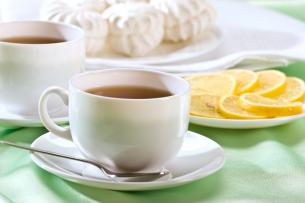
Cruising the tea section of your grocer store can bring on a dizzy spell — there are so many varieties to choose from these days! But that doesn’t mean you’ve got to stick to only those you already know. This primer will try to help you understand (and experiment with) a wider range of this delicious beverage.
Loose or Bagged?
Most people are familiar with bagged tea, which comes in a little pouch, either on a string or without. The bag keeps the leaves contained, while allowing the flavor of the tea to seep into the water. Although bagged tea is the simplest to use, loose teas have come back into style.
To brew loose tea, you need to use something to keep the tea leaves from fluttering about in the mug. There are many types of tea “infusers” in many different price ranges.
Black, Green and More
The most popular teas are:
Green: Green teas have zoomed in popularity because some studies suggest that regular consumption of them can keep heart disease and certain types of cancer at bay. Green tea is processed less than other teas, and remains richer in antioxidants (and has the least amount of caffeine). From a taste perspective, people say it has a “flowery” or “spring” flavor. In China, green tea is the most-consumed beverage — an average of 3 cups per day per person. Drink green tea plain or with just a hint of sugar.
Black: Here’s a tea that has some backbone. The stuff is flavorful, and tea newbies sometimes find it comes on strong. It has a higher concentration of caffeine than other tea varieties, and it is the most popular tea in the U.S. Some examples of black tea are: Orange Pekoe, Earl Grey, English Breakfast and Darjeeling. Researchers are now saying that black tea has health benefits similar to those of green tea. In the cup, it has that familiar reddish-brown color that most folks associate with tea, and most folks drink it with milk and sugar or lemon.
White: This variety is one of the newest to western culture, and it has a very pale yellow color and is quite subtle in flavor. It is the least processed of all teas and is rarer. Adding a little sugar or keeping it plain is the way to go.
Oolong: It’s a funny name for a very pricey kind of tea. Most people think that oolong teas taste something like peaches. The flavor can best be described as a cross between green and black tea — not too strong and not too wimpy. Drink it straight or with a shot of sugar. There’s lot of talk about oolong promoting weight loss, but that’s yet to be proven.
Flavored/Herbals: These are not really true teas, but rather a mixture of flowers, herbs and spices. Herbals are thought to have medicinal properties; for example, Chamomile is often recommended for good digestion. Flavored teas have also gained popularity, and the varieties are endless: peppermint, banana, vanilla and anything else tea-preneurs have invented.
Making Hot Tea:
- You can use a tea pot or a small cooking pot. Tip: Make just enough water for the cups you want to brew; the more water you have, the longer it will take to boil.
- Always start with cold, fresh water (never reuse water you’ve already boiled for a previous pot of tea). Don’t use hot water straight out of the tap, either.
- Put your tea bag (or infuser) into the cup and then pour your boiling water into your mug. Let it brew for 3 to 5 minutes, remove your teabag (infuser) and give it a gentle stir.
- For black tea, you may add milk, sugar, cream or even lemon to flavor. Most folks don’t add any flavoring other than a bit of sugar to the other tea varieties. But hey, your tea is up to you!
- If you like your tea iced, simply let it cool down a bit and add a few ice cubes for a refreshing summer drink.
And just so you know, tea leaves can actually be used to make cookies. Check out this tea cookie recipe.
If you are new to startcooking, or are a regular visitor here, please consider subscribing for free.








































George said:
Good blog! I personally enjoy Orange Pekoe the best. It reminds me most of the PG Tips I used to drink in England. However, it really is more of a dinner tea, not that that is a bad thing! For morning teas you really can’t go wrong with Earl Grey, or an Earl Grey – Lavender blend…..awesome.